8 Most Sustainable Training Shoe Brands: The Conscious Consumer’s Guide
Impactful Ninja is reader-supported. When you buy through links on our site, we may earn an affiliate commission.
Learn more
Learn more
.
Hey fellow impactful ninja ? You may have noticed that Impactful Ninja is all about providing helpful information to make a positive impact on the world and society. And that we love to link back to where we found all the information for each of our posts. Most of these links are informational-based for you to check out their primary sources with one click. But some of these links are so-called "affiliate links" to products that we recommend. First and foremost, because we believe that they add value to you. For example, when we wrote a post about the environmental impact of long showers, we came across an EPA recommendation to use WaterSense showerheads. So we linked to where you can find them. Or, for many of our posts, we also link to our favorite books on that topic so that you can get a much more holistic overview than one single blog post could provide. And when there is an affiliate program for these products, we sign up for it. For example, as Amazon Associates, we earn from qualifying purchases. First, and most importantly, we still only recommend products that we believe add value for you. When you buy something through one of our affiliate links, we may earn a small commission - but at no additional costs to you. And when you buy something through a link that is not an affiliate link, we won’t receive any commission but we’ll still be happy to have helped you. When we find products that we believe add value to you and the seller has an affiliate program, we sign up for it. When you buy something through one of our affiliate links, we may earn a small commission (at no extra costs to you). And at this point in time, all money is reinvested in sharing the most helpful content with you. This includes all operating costs for running this site and the content creation itself. You may have noticed by the way Impactful Ninja is operated that money is not the driving factor behind it. It is a passion project of mine and I love to share helpful information with you to make a positive impact on the world and society. However, it's a project in that I invest a lot of time and also quite some money. Eventually, my dream is to one day turn this passion project into my full-time job and provide even more helpful information. But that's still a long time to go. Stay impactful,Affiliate Disclosure
Why do we add these product links?
What do these affiliate links mean for you?
What do these affiliate links mean for us?
What does this mean for me personally?
![]()
Amid growing concerns about the textile industry’s environmental impact, there is pressure to find greener clothes for your wardrobe, from party dresses to training shoes. Unfortunately, fashion greenwashing makes it harder for you and all other consumers to figure out which clothing brands offer the most eco-friendly garments. So, we had to ask: Which are the most sustainable training shoe brands?
The most sustainable training shoe brands are Allbirds, VEJA, and IceBug, which prioritize low-impact, renewable materials, reduce waste, and strive for circularity. In addition, Vivobarefoot and On commit to low carbon footprints and supply chain transparency.
Whether you are searching for the perfect pair of training shoes for gym workouts or outdoor runs to add to your wardrobe without negatively impacting the soil, the water, the animals, and other people, there is a brand for you. So, let’s keep reading to learn more about the most sustainable sock brands and how they ensure sustainable, ethical practices.
Here’s How We Selected the 8 Most Sustainable Training Shoe Brands
The fast fashion industry has pushed for training shoes to be trendy and frequently replaced. Yet, the environmental impacts of making and landfilling training shoes can be enormous, especially with certain materials.
“Sustainable: The ability to be maintained at a certain rate or level | Avoidance of the depletion of natural resources in order to maintain an ecological balance”
Oxford Dictionary
The brands on this list were chosen based on their commitment and actions to promote sustainable practices while reducing the environmental impacts of the textile industry.
They are transparent about their materials, processes, and workforce management within their supply chain.
Some brands focus their efforts on reducing waste and optimizing natural resources while others strive to reduce the carbon footprint of their clothes.
All of these brands share the commitment to reshape the textile industry toward a more sustainable and Earth-friendly sector.
These Are the 8 Most Sustainable Training Shoe Brands
Most Sustainable Training Shoe Brands
Overall, these training shoe brands are sustainable. Yet, they take various approaches to reduce environmental impacts and uphold ethical standards. Let’s dive into each brand and find out more.
Allbirds: Simple and Comfortable Footwear Made With Nature-Based Materials

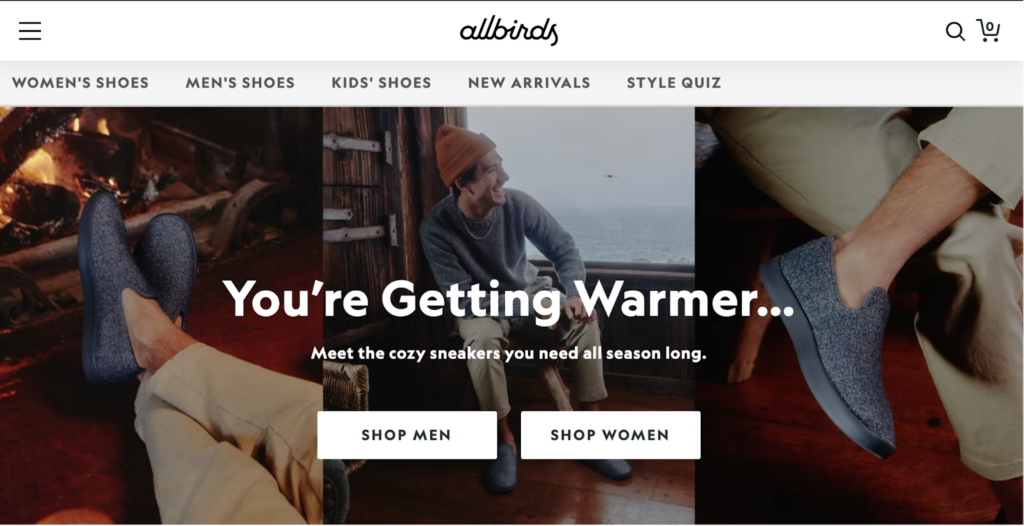
“Reducing the carbon footprint of our products is at the heart of everything we do.”
Allbirds
🌎
How do they ensure their sustainability?
Allbirds ensures sustainability by committing to a concrete plan to achieve net zero carbon by 2030 through meticulously measuring their carbon footprint and working to reduce the emissions beyond carbon neutrality while offsetting the current emissions to operate as a carbon-neutral business. They rely on renewable materials, regenerative agriculture, and responsible energy to reduce their carbon footprint. Specifically, Allbirds sources natural and recycled fabrics to replace petroleum-based synthetic textile materials. The brand invented their own nature-based alternative called SweetFoam®, as found in Trail Runners SWT shoes, their shoe sole material derived from the world’s first carbon-negative green EVA (ethylene-vinyl acetate). Also, the springy and responsive midsole SwiftFoam™, used in another training shoe line, Tree Flyer, has 48% bio content. They’ve also invested in novel solutions, like Plant Leather, a 100% natural, plant-based leather. Additionally, more than 60% of their merino wool currently comes from regenerative agriculture, which has the potential to reverse climate change while promoting biodiversity. Further down the life-cycle, Allbirds actively reduces their carbon footprint in manufacturing and transporting by using renewable energy in their “owned & operated” facilities and their finished goods manufacturers, shipping by boats, and reducing 40% packaging material by using one post-consumer recycled cardboard as a 2-in-1 shoe box/shipping box. In spring 2024, Allbirds plans to launch M0.0NSHOT—a net zero carbon shoe (a standard sneaker has an average footprint of about 14 kg CO2 eq). Lastly, they encourage buying and selling slightly imperfect and gently used Allbirds products on Allbirds ReRun™ to extend the products’ life-cycle.
🌐
How do they ensure their ethics?
Allbirds has a Supplier Code of Conduct, drawing upon ILO Core Labor Standards to ensure safe working conditions, respect and dignity for workers, and environmentally responsible manufacturing processes in Allbirds’ supply chain. They require independent, third-party social and environmental audits of their Tier 1 suppliers. They also strive for transparency and traceability in their supply chain: 100% of their Tier 1 and Tier 2 suppliers are currently mapped with a target to reach 100% supply chain traceability by 2025. Additionally, their Animal Welfare Policy ensures their merino wool is held to high farming standards, land management, and animal welfare. Their merino wool is also certified by ZQ Merino, covering sustainability and ethics from farm to fashion.
🤝
Are they part of any giving-back programs?
Allbirds donates slightly used shoes returned by customers to Soles4Souls, an organization that helps to empower people living in poverty by creating jobs for them. During the COVID-19 pandemic, Allbirds supported healthcare workers by donating shoes and running a “buy one, give one” option, enabling customers to get involved and show appreciation for those making a difference.
🛍️
What is their product range?
- Best for: womenswear, menswear, kidswear
- Product range: sneakers, socks
- Price range: $$
- Size range: XS–XXL
VEJA: Sneakers Made With Innovative, Low-Impact Materials
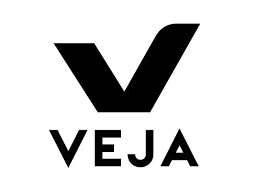
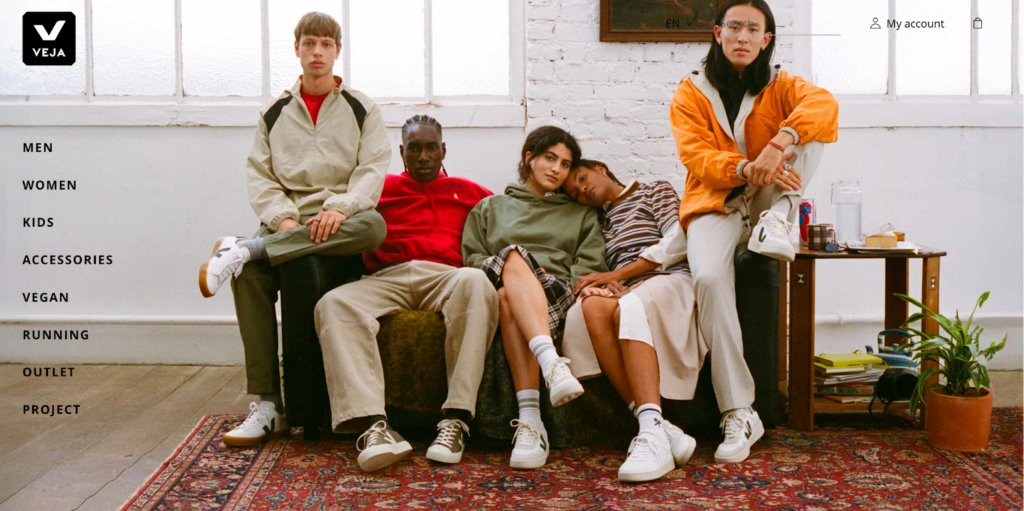
“VEJA is walking on two feet: ecology and social justice on one side, design on the other. We never compromise between the both of them.”
Sebastien Kopp, Co-Founder of VEJA
🌎
How do they ensure their sustainability?
VEJA ensures sustainability by opting for a high proportion of low-impact materials and reducing textile waste. In 2020, recycled polyester and organic cotton made up nearly 76% of their sneaker materials. Specifically, their IMPALA training shoes are made with 100% recycled polyester upper, lining, and laces. VEJA also uses other eco-friendly materials, including organic jute and recycled cotton. With leather, the traditional shoe material, VEJA strives to improve traceability and transparency. All their tanning partners are Gold certified by the Leather Working Group, which promotes sustainable environmental practices in the leather industry. VEJA also discloses the total carbon emissions released throughout their supply chain and the equivalent carbon footprint of various models. By working out the proportion of their emissions, they identify the hot spots and reduce their footprints in multiple ways, including using renewable energy, improving the most-polluting products (leather-based sneakers), reducing air freight for transportation from factories to retailers, and taking the train as the main transporting methods for team members. In June 2020, they launched their VEJA x Darwin project, a test hub for cleaning, repairing, and recycling old sneakers, keeping materials longer in circulation while reducing waste and carbon footprint.
🌐
How do they ensure their ethics?
Fair trade is one of the three fundamental pillars VEJA is built on. They work directly with producers and use annual contracts to guarantee income and a reasonable price for producers. Workers who manufacture VEJA sneakers are well compensated and live in normal conditions. Their Supplier Code of Conduct covers the ILO’s Four Fundamental Freedoms principles. VEJA also traces most of their supply chain and visits their suppliers regularly.
🤝
Are they part of any giving-back programs?
VEJA partners with Log’ins (Logistics & Insertion), an organization that employs people with light disabilities and promotes their social inclusion. In 2022, more than 200 employees recognized as disabled workers were supported by Log’ins.
🛍️
What is their product range?
- Best for: womenswear, menswear, childrenswear
- Product range: sneakers
- Price range: $$
- Size range: XS–XXL
Icebug: Climate Positive Shoes Made in Fair Conditions
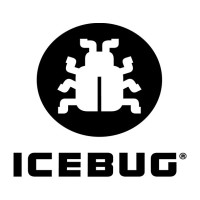
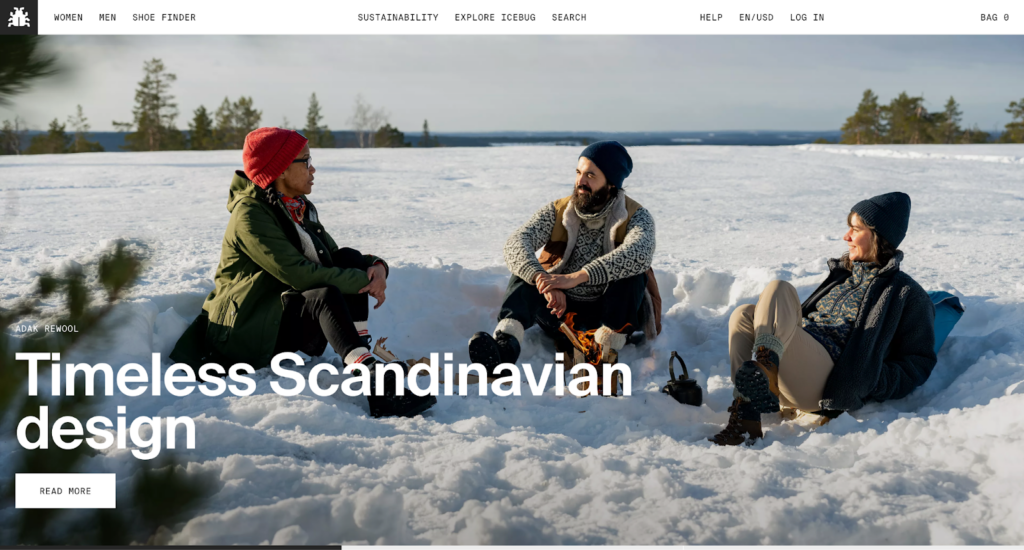
“We could release many more niche styles in trending colors, but we’re not trying to ride the waves of microtrends. We want to sell functional shoes that last over time and that you’ll wear for years to come. Therefore, we opt out of temporary trends in favor of quality that lasts.”
Icebug
🌎
How do they ensure their sustainability?
Icebug ensures sustainability by reducing the carbon footprint of their shoes and offsetting twice as much as their carbon emissions to help create a world with less CO2 emissions as quickly as possible. Regarding carbon reduction strategies, Icebug avoids sourcing materials associated with deforestation, opting for recycled fabrics or bio-based textiles instead of virgin fossil-based synthetic materials, and having supplies shipped by boats. Specifically, Icebug started a pilot project with Nordic SPOOR to ensure that the leather in their shoes is traceable and that its production does not contribute to deforestation. Additionally, they source FSC-certified natural rubber. In order to reduce reliance on non-renewable fossil fuels and cut down emissions, they also replace virgin synthetic fabrics with recycled materials, such as GRS-certified recycled polyester and recycled nylon (sourced from Cordura and Milspeed). For example, the upper of the Aura ReWool Walking Shoe is made with a blend of 50% recycled polyester and 50% recycled wool. They are also looking into the prospect of recycling foams, closing the loop, or use 100% bio-based foams. Their BLOOMTM foam, for example, contains algae biomass, helping to reduce their dependence on oil. Lastly, they ship their shoes from their Asian manufacturing partners to Europe using boat transport (not air transport) to reduce carbon emissions. Their carbon reduction strategies resulted in a reduction from 12.9 kg CO2 per pair of shoes in 2015 to 11.0 kg CO2 in 2021/22. Better yet, they compensate for their (yet) unavoidable carbon emissions by 200% through investing in highly credible projects and partners, such as Gold Standard, CDM, and 1% for the Planet. Specifically, their total 2021/2022 compensation was 8,260 tons CO2 for a total footprint of 3,992 tons CO2.
🌐
How do they ensure their ethics?
Icebug upholds their suppliers to a Code of Conduct that covers four of ILO’s Fundamental Principles and Rights at Work. The final manufacturing stage of their shoes is certified by the Fair Wear Foundation, ensuring safe and fair working conditions for the textile workers. Regarding animal welfare, they source animal-derived materials certified by sustainable and ethical standard systems, such as Responsible Wool Standard for their wool fabrics and Leather Working Group for their leather fabrics.
🤝
Are they part of any giving-back programs?
Icebug is a member of 1% for the planet, pledging at least 1% of their revenue to projects that protect the planet. From February 2020 to February 2021, they donated to Protect Our Winter ($50,000), Naturarvet, focusing on forest protection ($45,000), and a pilot project to replace coal power with energy from solar panels on factory roofs ($35,000).
🛍️
What is their product range?
- Best for: menswear, womenswear
- Product range: winter boots, walking shoes, hiking shoes, running shoes, winter running shoes, T-shirts, socks, accessories
- Price range: $$$
- Size range: XS–XL
Vivobarefoot: Training Shoes Based On Barefoot Principles and Regenerative Business Model
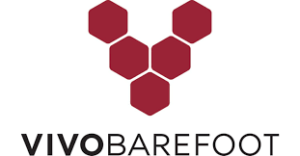
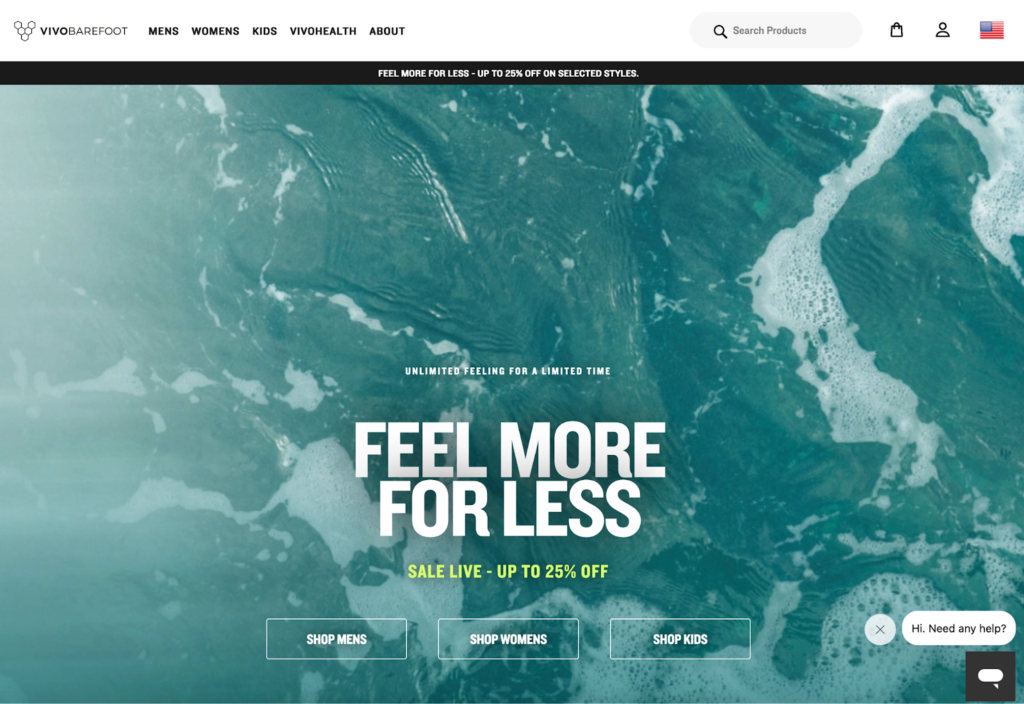
“At Vivobarefoot, we are committed to being a regenerative business both inside and out. This means our business is one that supports the connection to natural systems for the people that work in our company, those who make our products and the people that wear them.”
Asher Clark, Co-Founder of Vivobarefoot
🌎
How do they ensure their sustainability?
Vivobarefoot ensures sustainability by working across every shoe’s life-cycle to develop products that will eventually regenerate planetary health. They first aim for circularity in footwear design so that their products, in the future, can be recyclable, compostable, or biodegradable. In order to do so, Vivobarefoot is currently working with innovators and industry experts to find better materials and reduce the complexity of their footwear without sacrificing durability. For example, they work with BLOOM to increase the amount of algae-based EVA foam used in their shoes. Secondly, Vivobarefoot is moving away from virgin materials and aiming to use materials from old Vivos to make new Vivos wherever possible. In their Motus Strength training shoe model, in particular, the insole is made of 98% recycled PU foam, the upper is made of 84% rPET collar knit, 100% rPET mesh, 100% rPET laces, and 100% rPET insole. In 2020, Vivobarefoot launched ReVivo, a program that revives worn shoes and returns them, reconditioned, keeping shoes on feet and away from landfills longer.
🌐
How do they ensure their ethics?
Vivobarefoot ensures their ethics by being fully transparent about their sustainability goals; the matrix they use to assess the environmental impact of their footwear (VMatrix); the framework that guides environmental, social, and governance actions within their brand (REFRAME); and the traceability of their value chain. Vivobarefoot also traces all their tier 1 and tier 2 suppliers. They share a frequently updated map of partners in their supply chain, detailing their roles and the business, social, and environmental data associated with each partner. On top of this, their Code of Conduct covers all four of ILO’s Fundamental Principles and Rights at Work. Regarding animal welfare, they use merino wool sourced from Woolmark-certified farms, where the sheep roam freely and are treated humanely.
🤝
Are they part of any giving-back programs?
Vivobarefoot uses their in-house impact fund, Livebarefoot Fund, to support science-led and nature-based innovations, including but not limited to Fashion for Good, Future Footwear Foundation, Biome Algae, Beaver Trust, and Wild Human.
🛍️
What is their product range?
- Best for: kidswear, menswear, womenswear
- Product range: sneakers, accessories, socks, T-shirts
- Price range: $$
- Size range: XS–XL
On: Innovative Sneaker Brand With Focus on Circularity
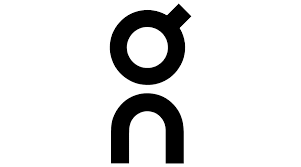

“We’re committed to advancement through innovation – whether that’s by rethinking the design and manufacture of our products or finding (and inventing) new technologies to achieve our vision”
On
🌎
How do they ensure their sustainability?
On ensures sustainability by moving toward fossil-free and innovative materials for their sneakers to increase performance and prevent injury while reducing the environmental impacts. They are en route to replace all virgin fossil-based materials with natural-based materials, recycled or bio-based plastics. Specifically, their 2022 collection was made with 94% organic, recycled, or petrol-free cotton, 85% recycled polyester, and 76% recycled polyamide. On also uses PA11, a bio-based nylon derived from caster beans, in the Cloudneo running shoes and the circular Cyclon-T running top. On the innovation frontier, On focuses on creating low-impact yet high-performing foams that boost take-offs and support landings. For example, their CleanCloud® are high-performance materials made from captured carbon emissions. Furthermore, On moves toward circularity by running platforms that facilitate reusing and recycling On products. Specifically, OnwardTM is On’s US-based re-commerce platform, enabling shopping and trading gently-used On gear. Onward aims to extend the life of On products and keep them out of landfills for as long as possible. On top of that, the brand operates a circularity program they trademarked Cyclon™, enabling consumers to pay a subscription to use their circular shoes Cloudneo, return them when worn, and repeat. The program is available in 33 countries. On also designs for circularity, meaning that material selection and structuring are selected for the ease of dissembling and recycling. Lastly, they use renewable energy in their supply chain to reduce their carbon emissions.
🌐
How do they ensure their ethics?
On ensures their ethics by being transparent about their supply chain. In 2022, there were 1,700 people from 79 different nationalities in their supply chain with no gender pay gap and 4 employee-led Inclusion Groups. Furthermore, they publicly list their manufacturing partners. On also upholds 100% of their Tier 1 suppliers to their Supplier Code of Conduct that follows ILO standards and audits their practices.
🤝
Are they part of any giving-back programs?
On gives back with an incentive to encourage people to run and move. They created Right to Run, a social impact program dedicated to democratizing movement across the globe in 2022. Through funding, support, and product donations, they supported 60,000 community members in 2022.
🛍️
What is their product range?
- Best for: womenswear, menswear
- Product range: road running shoes, hiking shoes, trail running shoes, lifestyle shoes, tennis shoes, pants, tops, bras
- Size range: XS–XL
Hylo Athletics: Vegan Training Shoes From Carbon Neutral Brand


“With science in our soles and renewability in our materials. The future is still ours to write.”
Hylo Athletics
🌎
How do they ensure their sustainability?
Hylo Athletics ensures their sustainability firstly by using renewable, circular, and resource-light materials while moving away from fossil-based materials and high-impact animal-derived fabrics (leather and wool). Specifically, they source PLA fabrics derived from corn and sugarcane, algae-based BLOOMTM, (organic) cotton, and REFIBRA™ (regenerated cellulose fibers made with pre and post-consumer recycled cotton) for their vegan sportswear. For example, their Hylo Run shoes are 60.03% bio-based. Hylo Athletics also prioritizes low-impact packaging materials. For shoe packaging, they use FSC-mix certified cardboard boxes engineered to be resealable and, thus, reusable. For garment packaging, they have partnered with Invisible Packaging to ensure their apparel is packed in water-soluble, compostable, biodegradable, and non-toxic bags. Hylo Athletics further pursues sustainability with waste reduction incentives, such as designing shoes with few parts (25% of the average running shoes), employing the flat-knitting technique to maximize materials, and dope dyeing yarns to save water. Moreover, their Hyloop platform helps extend their products’ life through care, repair, and recycling, keeping materials in circulation longer and cutting down waste. Continuing on, they reduce their carbon footprint by using materials that emit less carbon, less energy-intensive processes, and a localized supply chain to offset all their carbon emissions. Last but not least, Hylo Athletics invests in a project installing biogas digesters in Sichuan that decompose organic waste, naturally turning it into a clean fuel that replaces the need to burn coal or wood.
🌐
How do they ensure their ethics?
Hylo Athletics’s production partner is based in China, a country with extreme risk of labor abuse. However, they conduct regular third-party audits on worker conditions, showing that 100% of workers are paid correctly and above the regional average. Hylo Athletics also publicly shares the list of their suppliers via Open Supply Hub. Additionally, they are transparent about the impact of their products, measuring and sharing the carbon footprint of each product line.
🤝
Are they part of any giving-back programs?
Since January 2021, Hylo Athletics has partnered with Common Goal to donate at least 1% of their net revenue as they work to pioneer their work on planetary impact.
🛍️
What is their product range?
- Best for: menswear, womenswear
- Product range: everyday trainers, performance running shoes, T-shirts, sweatshirts, shorts, sweatpants, accessories
- Price range: $$
- Size range: XS–XL
Ethletic: Traceable Sneakers Made With Natural and Recycled Materials
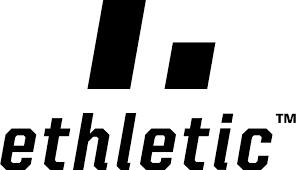
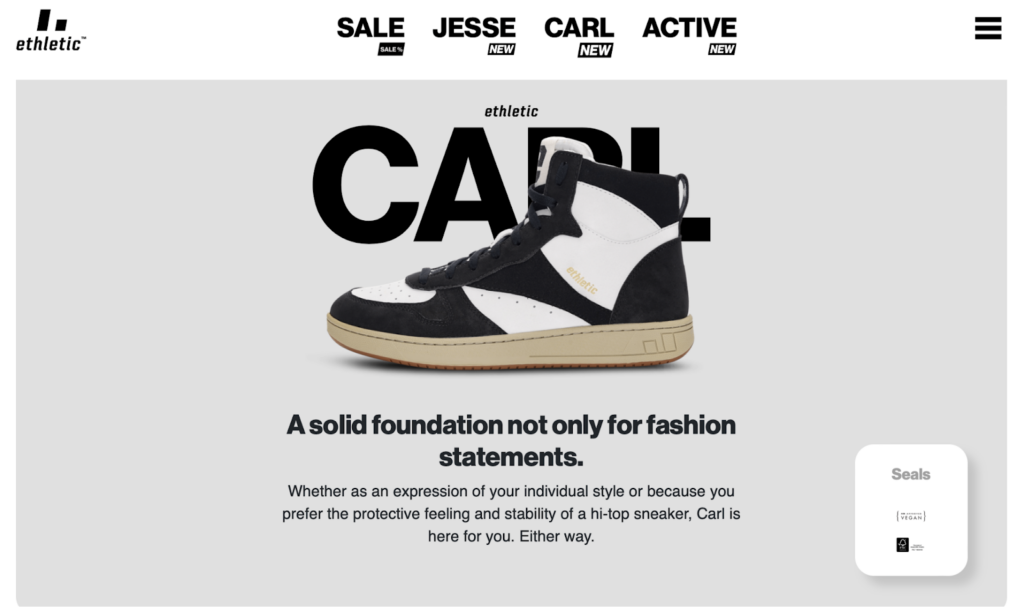
“The people who work for Ethletic aren’t numbers on a balance sheet or a cost factor for us. We know these people. We appreciate them and their skills, their commitment, their history.”
Ethletic
🌎
How do they ensure their sustainability?
Ethletic promotes sustainability by using a high proportion of eco-friendly materials. Specifically, for their signature shoes, they source canvas based on Fairtrade organic cotton for the uppers and FSC-certified rubber for the soles. Additionally, Ethletic uses GRS-certified recycled PU leather in some models to achieve high comfort and guaranteed perfect fit. Further down the life-cycle in the manufacturing stage, Ethletic shoes are built in a way that allows future separation and recycling, a first step toward going circular. Regarding transportation, Ethletic commits to “no air shipment,” transporting all their sneakers exclusively by ships. Since 2019, they have offered their customers a discounted repair option in collaboration with Berlin-based start-up Sneaker Rescue, helping to extend the lifespan of the sneakers and reduce pressure on the environment.
🌐
How do they ensure their ethics?
Ethics is at the center of Ethletic’s operation. Their manufacturing partner is Fairtrade-certified and has a premium-funded worker society, ensuring fair working conditions and treatment for their workers. Specifically, for each pair of shoes sold, one US dollar is paid as a premium to the Talon Fair Trade Workers Welfare Society. A democratically elected group then decides which health care and educational projects to use this money for. Ethletic also traces their whole supply chain and audits most of their suppliers. They disclose the workers who make their products and enable visitors to tip these workers directly on their website. Additionally, Ethletic commits to product traceability, including the total distance traveled from fabric to brand and the material composition.
🤝
Are they part of any giving-back programs?
Ethletic is not known to be part of any giving-back programs.
🛍️
What is their product range?
- Best for: menswear, womenswear
- Product range: sneakers
- Price range: $$
- Size range: XS–XL
CARIUMA: Sneakers Designed for Style, Comfort, and Sustainability
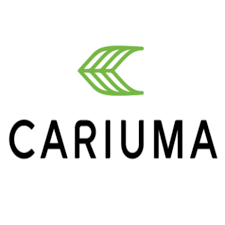
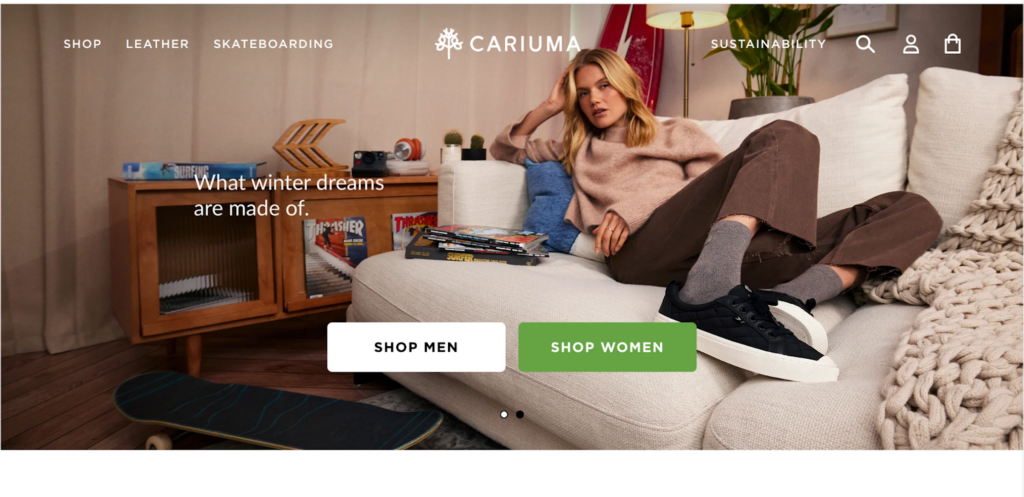
“We iterate a sneaker style for a year + before we bring it to production and we attempt to reduce the number of steps it takes to manufacture (which saves energy and time).”
CARIUMA
🌎
How do they ensure their sustainability?
CARIUMA prioritizes sustainability by increasing the natural content of their products. In particular, they prioritize materials that renew quickly, like bamboo and sugarcane, and plant-derived substances, such as cork and rubber, that can be harvested without cutting down trees. CARIUMA also sources lower-impact alternatives to conventional sneaker materials, for example, organic cotton instead of cotton, mamona oil instead of petroleum, recycled nylon instead of virgin nylon, and rPET (recycled PET—polyethylene terephthalate—plastic) instead of virgin plastics. The leather used in CARIUMA sneakers is sourced, tanned, and finished with low-waste methods, renewable and recycled inputs, and fewer chemicals. Their responsible practices involve recycled water, renewable energy, and a closed-loop tanning chemical system to protect the surrounding land and groundwater. CARIUMA exclusively sources leather as a byproduct of best-practice food industry cattle, which are steroid-free and grass-fed on naturally treeless plains indigenous to South America. Furthermore, they reduce their carbon footprint via a series of initiatives, including using solar energy, LED lighting, and a cooling tower in their warehouse, delivering sneakers in one recycled and recyclable paper box (which acts as both packaging and a shoe box), and opting for a carbon-neutral shipping option.
🌐
How do they ensure their ethics?
CARIUMA binds their suppliers to a Code of Conduct that covers all of the ILO’s Fundamental Freedoms Principles. They also trace most of their supply, specifically 100% of Tier 1 suppliers—the footwear manufacturer; 85% of Tier 2 suppliers involving raw material processors, mills, knitting, packaging, outsole factory, and components in general; and 59% of their Tier 3 suppliers who provide yarns, polymers, and chips. Additionally, their manufacturing partner is audited annually by WRAP. They also visit their suppliers routinely. Regarding the use of animal skins in their leather sneakers, CARIUMA has an Animal Welfare Policy, ensuring animal welfare standards and transparency in the leather supply chain. Their leather suppliers are certified and audited by the Leather Working Group (LWG).
🤝
Are they part of any giving-back programs?
Since June 2020, CARIUMA has committed to planting two trees for every pair of sneakers they sell. Their reforestation program started in Brazil, with over 2 million trees planted. They work closely with the local indigenous communities, following their guidance on how to tend to the land and best support regrowth and restoration, improve seed storage efficiency, and go about replanting methods that mitigate risk and preserve biodiversity.
🛍️
What is their product range?
- Best for: womenswear, menswear
- Product range: sneakers
- Price range: $$
- Size range: XS–XL
Why Is It Important to Buy Products Made of More Sustainable Fabrics
It is important to buy products made of more sustainable fabrics because a sustainable textile industry has a lower carbon footprint, helps save natural resources, and is better for forests, animals, and humans.
Buying Sustainable Fabrics Reduces Your Carbon Footprint
The production of clothing and footwear is estimated to contribute 10% of global greenhouse gas emissions—more than all international flights and shipping combined. If the fashion industry were a country, it would be the fourth largest emitter of carbon dioxide.
One way to reduce the carbon footprint of the clothes you buy is to opt for sustainable fabrics. Sustainable fabrics, which are often made with natural or recycled fibers, have relatively low carbon footprints compared to petroleum-based fabrics. For example, organic cotton made in the US has a carbon footprint of 2.35 kg CO2 (per ton of spun fiber)—a quarter of polyester’s carbon footprint.
Buying Sustainable Fabrics Reduces Demand For Natural Resources and Waste Management
The textile industry uses water and land to grow cotton and other fibers. It is estimated that 79 billion cubic meters of water were used for the sector worldwide in 2015. For example, producing a single cotton T-shirt requires as much water as one person drinks for 2.5 years (2,700 liters of fresh water).
Worse yet, the textile economy is vastly more linear than circular: the largest amount of resources used in clothes ended up in landfills (instead of being recycled to remake clothes). According to a report by the Ellen MacArthur Foundation,
- Less than 3% of materials used in the textile economy in 2015 came from recycled sources.
- In other words, more than 97% of resources used in making clothes are newly extracted.
When clothing items are disposed of within a short period of time—under a year in the case of half of the fast fashion clothes—the natural systems that provide raw materials for fabrics don’t have enough time to recover and regenerate, which could lead to ecological breakdown.
Sustainable fabrics are made with less water and emissions while lasting longer:
- Because they are durable, you don’t need to buy new clothes too often.
- Thus, you help reduce the pressure to extract more resources for making new items.
Similarly, making and consuming sustainable fabrics made with recycled materials reduces the demand for virgin materials while helping tackle waste management.
Buying Sustainable Fabrics Encourages Sustainable Management of Forests
Sustainable natural fiber fabrics are made with raw materials from forests and plantations that are sustainably managed, such as complying with FSC standards.
When you buy sustainable natural fiber fabrics, you discourage unsustainable forestry practices like illegal logging. You can help reduce deforestation, biodiversity loss, and the effects of climate change.
Buying Sustainable Fabrics Encourages Fairer Treatment of Animals
The fashion industry is rife with animal mistreatment when it comes to making animal-based fabrics like wool or silk. Every year, billions of animals suffer and die for clothing and accessories.
Buying sustainable vegan alternatives can help to reduce the pressure on raising more and more animals to meet the demand for animal-based fabrics while sacrificing their well-being and lives.
Suppose you have to buy fabrics made with, for example, wool or silk; make sure you only choose brands committed to cruelty-free products. In that case, you help advocate better treatments for animals raised within the textile industry.
Using Sustainable Fabrics Encourages Fairer Treatment of Textile Workers
Recent statistics from UNICEF estimated as many as 170 million child laborers worldwide, many of whom were engaged in some form of work in the textile industry. They don’t get paid minimum wages and often work long hours.
When you buy sustainable fabrics from brands transparent about the working conditions at their factories, you discourage the use of child labor and help promote better working conditions for textile workers.
How Can You Generally Buy More Sustainable Fabrics
The key to sustainably buying fabrics is to check on relevant environmental and original certifications.
For natural fabrics:
- Global Organic Textile Standard (GOTS): A globally recognized certification system that ensures a certain threshold of organic content has been met. It covers manufacturing, packaging, labeling, transportation, and distribution (but not what happens in the fields where crops are grown).
- USDA Certified Biobased Product: The USDA BioPreferred® Certification is a voluntary certification offered by the United States Department of Agriculture. The certification identifies products made from plants or other renewable materials.
- Ecolabel: Ecolabel is the official European Union voluntary label recognized worldwide for certified products with a guaranteed, independently verified low environmental impact. The label requires high environmental standards throughout the entire life-cycle: from raw material extraction through production and distribution to disposal. It also encourages companies to develop innovative, durable, easy-to-repair, and recyclable products.
For natural fiber semi-natural/semi-synthetic fabrics:
- Forest Stewardship Council: An FSC certification ensures that the wood (or wood-like material) comes from responsibly managed forests that provide environmental, social, and economic benefits.
There are two types of FSC Certification:- FSC Forest Management Certification, with a focus on the origin of the wood—the forest.
- FSC Chain of Custody Certification, which focuses on the path from the forest to the customer’s home.
- Program for Endorsement of Forest Certification: PEFC’s approaches to sustainable forest management are in line with protecting the forests globally and locally and making the certificate work for everyone. Getting a PEFC certification is strict enough to ensure the sustainable management of a forest is socially just, ecologically sound, and economically viable but attainable not only by big but small forest owners.
For recycled fabrics:
- Recycled Claim Standard (RCS): The Textile Exchange RCS was originally developed as an international, voluntary standard that sets requirements for third-party certification of Recycled input and chain of custody.
- The Global Recycled Standard (GRS): The Global Recycled Standard (GRS) is an international, voluntary, full product standard that sets requirements for third-party certification of Recycled Content, chain of custody, social and environmental practices, and chemical restrictions. It can be used for any product with more than 20% recycled material.
For all types of fabrics:
- STeP by OEKO-TEX®: STeP by OEKO-TEX® is an independent certification system for brands, retailers, and manufacturers from the textile and leather industry. It communicates organizational environmental measures, including reducing carbon footprint and water usage.
- OEKO-TEX® Standard 100: OEKO-TEX® labels aim to ensure that products pose no risk to human health (i.e., containing banned chemicals).
Some certifications that are signaling brands’ efforts toward lowered environmental impacts and a circular economy are:
- B Corp Certification: The label B Corp is a certification reserved for for-profit companies. Certified holders are assessed on their social and environmental impacts.
- Cradle2Cradle certification: Cradle2Cradle provides a standardized approach to material circularity. It assesses whether products have been suitably designed and made with the circular economy in mind covering five critical categories: material health, material reuse, renewable energy and carbon management, water stewardship, and social fairness.
Final Thoughts
Training shoes are often trendy status symbols that, because of the challenge in recycling them and their conventional use of high-impact materials, can have severe adverse environmental impacts. Thus, it is important to shop with ethics and sustainability in mind when choosing your next pair.
By purchasing new or pre-loved training shoes from brands that commit to sustainability, you support their mission to create a fairer and less harmful textile industry for all lives on Earth.
Here is the list (again) of the most sustainable sneaker brands:
- Allbirds
- VEJA
- Icebug
- Vivobarefoot
- On
- Hylo Athletics
- Ethletic
- CARIUMA
To make your use of these shoes even more sustainable, follow these steps:
- Buy second-hand, recycled, or upcycled training shoes made with low-impact materials.
- While using training shoes, maximize the number of wears between washes and keep them as long as possible.
- At the end-of-life of your training shoes, upcycle the materials to extend their usage and arrange for them to be recycled or properly disposed of.
Stay impactful,

Sources
- Science Direct: Life-cycle assessment (LCA)
- Allbirds: Home
- VEJA: Home
- Icebug: Home
- Vivobarefoot: Home
- On: Home
- Hylo Athletics: Home
- Ethletic: Home
- CARIUMA: Home
- B Corporation: Allbirds
- Allbirds: Active shoes
- Allbirds: Sustainability Guide & Practices
- Allbirds: What’s in a Footprint | Sustainability Practices
- Allbirds: Carbon OffsetsSustainability Practices
- Allbirds: Renewable Materials | Sustainability Practices
- Allbirds: Regenerative agriculture | Sustainability Practices
- Allbirds: Responsible energy | Sustainability Practices
- Impactful Ninja: How Sustainable Are Recycled Fabrics? A Life-Cycle Analysis
- Impactful Ninja: How Sustainable Are Synthetic Fabrics? A Life-Cycle Analysis
- Allbirds: Our Materials | SUGAR
- Allbirds: Trail Runners SWT
- Allbirds: Tree Flyer
- Allbirds: Our Story
- Impactful Ninja: How Sustainable Are Merino Wool Fabrics? A Life-Cycle Analysis
- Allbirds: What is your commitment to sustainability?
- Allbirds: M0.0NSHOT
- Allbirds: Allbirds ReRun™
- Allbirds: Supplier Code of Conduct
- ILO: Labor Standards
- Allbirds: How We Operate
- Allbirds: Tier 1 Suppliers
- Allbirds: Animal Welfare Policy
- Discovery ZQ: Home
- Soles4Souls: Home
- The Robin Report: Allbirds: Pioneering Sustainable Footwear
- Impactful Ninja: How Sustainable Are Recycled Polyester Fabrics? A Life-Cycle Analysis
- Impactful Ninja: How Sustainable Are Organic Cotton Fabrics? A Life-Cycle Analysis
- VEJA: Transparency
- Impactful Ninja: How Sustainable Are Jute Fabrics? A Life-Cycle Analysis
- Impactful Ninja: How Sustainable Are Recycled Cotton Fabrics? A Life-Cycle Analysis
- VEJA: Leather
- VEJA: The blindness around CO2 emissions
- VEJA: Limits
- VEJA: Fair trade
- VEJA: Production
- Good On You: Brand Directory | VEJA
- VEJA: Reintegration
- B Corporation: Icebug
- Icebug: Women’s Walking Shoes
- Icebug: Women’s Hiking Shoes
- Icebug: Women’s Running Shoes
- Icebug: Women’s Winter Running Shoes
- Icebug: Materials
- Icebug: Our Promise | Great shoes. Fair conditions. Radical transparency.
- Nordic Spoor: Home
- Impactful Ninja: How Sustainable Are Leather Fabrics? A Life-Cycle Analysis
- Forest Stewardship Council: Home
- Textile Exchange: Global Recycle Standard
- Impactful Ninja: How Sustainable Are Recycled Nylon Fabrics? A Life-Cycle Analysis
- Cordura: Sustainability
- Milspeed: Home
- Icebug: Aura ReWool Walking Shoe
- Impactful Ninja: How Sustainable Are Recycled Wool Fabrics? A Life-Cycle Analysis
- BLOOM Materials: Home
- 1% For the Planet: Home
- Icebug: Code of Conduct
- Good On You: Brand Directory | Icebug
- International Labour Organization: ILO Declaration on Fundamental Principles and Rights at Work
- Icebug: FAIR WEAR Brand Performance Check
- Fair Wear Foundation: Home
- Textile Exchange: Responsible Wool Standard
- Impactful Ninja: How Sustainable Are Wool Fabrics? A Life-Cycle Analysis
- Leather Working Group: Home
- Protect Our Winter: Home
- Icebug: Icebug & Naturarvet
- B Corporation: Vivobarefoot
- Vivobarefoot: Men’s Performance Shoes
- Vivobarefoot: About Us
- Vivobarefoot: Our Materials
- Bloom Materials: RISE ALGAE-BLENDED EVA
- Vivobarefoot: BIO WEAR MORE PLANTS
- Vivobarefoot: INTEGRATED ANNUAL REPORT 22/23 | UNFINISHED BUSINESS
- Vivobarefoot: Motus Strength
- Vivobarefoot: ReVivo
- Vivobarefoot: VIVOBAREFOOT RISK AND MATERIALITY ASSESSMENT
- Vivobarefoot: Our Value Chain Partners
- Vivobarefoot: Code of Conduct
- Good On You: Brand Directory | Vivobarefoot
- The Woolmark Company: Home
- Vivobarefoot: Livebarefoot Fund
- Fashion for Good: Home
- Future Footwear Foundation: Home
- Vivobarefoot: VIVOBAREFOOT X WILD HUMAN
- On: Road Running Shoes
- On: Hiking Shoes
- On: The Movement Lifestyle Collection
- On: Our Impact—Our Progress | The 2022 Impact Progress Report
- Impactful Ninja: How Sustainable Are Recycled Polyamide Fabrics? A Life-Cycle Analysis
- Impactful Ninja: How Sustainable Are Nylon Fabrics? A Life-Cycle Analysis
- On: Men’s Cloudneo
- On: Cyclon™ Program: Fully Recyclable Running Gear
- On: CleanCloud®
- On: OnwardTM by On
- On: Help Center | Cyclon™
- On: Sustainability
- On: Transparency & Responsibility
- On: Supplier Code of Conduct
- On: Right To Run
- B Corporation: Hylo Athletics
- Impactful Ninja: How Sustainable Are PLA Fabrics? A Life-Cycle Analysis
- Hylo Athletics: BALANCING PERFORMANCE AND IMPACT
- Lenzing: REFIBRA™
- Hylo Athletics: WHY OUR SPORTSWEAR IS VEGAN?
- Hylo Athletics: Women’s Hylo Run
- Sustainable Jungle: 9 Sustainable Running Shoes – Run Like The World Depends On It
- Hylo Athletics: OUR PACKAGING
- Invisible Company: Home
- Hylo Athletics: REDUCING A SHOE’S IMPACT
- Hylo Athletics: Recycling | Hyloop
- Hylo Athletics: Carbon
- Good On You: Brand Directory | Hylo Athletics
- Hylo Athletics: Suppliers
- Open Supply Hub: Home
- Hylo Athletics: HOW WE WORK OUT OUR CARBON FOOTPRINT
- Hylo Athletics: Giving Back
- Ethletic: ACTIVE
- Good On You: Brand Directory | Ethletic
- Fairtrade: Home
- Forest Stewardship Council: Home
- Ethletic: SUSTAINABILITY
- Ethletic: Ethletic Story
- Sneaker Rescue: Home
- Fairtrade: Fairtrade Premium preview
- Ethletic: Fair For All
- Tracycle: Ethletic
- CARIUMA: Shoes for Skaters
- B Corporation: CARIUMA
- CARIUMA: EMPOWERING SUSTAINABLE CHOICES | Materials
- Impactful Ninja: How Sustainable Are Organic Cotton Fabrics? A Life-Cycle Analysis
- Impactful Ninja: How Sustainable Are Cotton Fabrics? A Life-Cycle Analysis
- Impactful Ninja: How Sustainable Are Recycled Nylon Fabrics? A Life-Cycle Analysis
- CARIUMA: What is Ethically Sourced Leather?
- CARIUMA: EMPOWERING SUSTAINABLE CHOICES | Operations
- CARIUMA: EMPOWERING SUSTAINABLE CHOICES | Factories
- CARIUMA: Code of Conduct
- Good On You: Brand Directory | CARIUMA
- CARIUMA: Leather sneakers
- CARIUMA: Animal Welfare Policy
- Leather Working Group: Home
- CARIUMA: REFORESTATION PROGRAM
- European Parliament: The impact of textile production and waste on the environment (infographic)
- Science Direct: The challenge of “Depeche Mode” in the fashion industry – Does the industry have the capacity to become sustainable through circular economic principles, a scoping review
- Science Direct: Carbon Footprint of Textile and Clothing Products
- European Parliament: Environmental impact of the textile and clothing industry
- European Parliament: What if fashion were good for the planet?
- Ellen MacArthur Foundation: A New Textiles Economy: Redesigning fashion’s future
- McKinsey: Style that’s sustainable: A new fast-fashion formula
- Forest Stewardship Council: Home
- Our World in Data: Deforestation and Forest Loss
- Our World in Data: Renewable Energy
- Peta: Animals Used For Clothing
- The Guardian: Child labour in the fashion supply chain
- BioPreferred: WHAT IS THE BIOPREFERRED PROGRAM?
- European Commission: Environment | EU Ecolabel
- Forest Stewardship Council
- FSC Forest Management Certification
- FSC Chain of Custody Certification
- Textile Exchange: The RCS and GRS are designed to boost the use of recycled materials
- Program for Endorsement of Forest Certification
- Impactful Ninja: How Sustainable Are Semi-Natural/Semi-Synthetic Fabrics? A Life-Cycle Analysis
- OEKO-TEX: Certification according to STeP by OEKO-TEX®
- B Corp Certification: Home
- C2CCertified: Home





